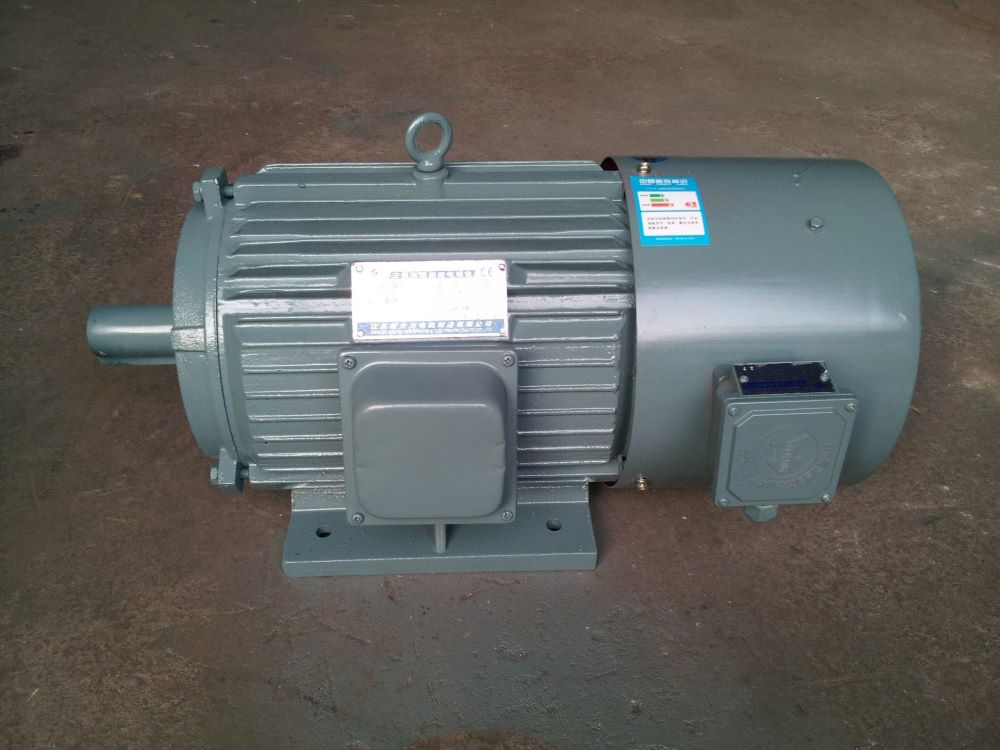มอเตอร์ปรับความเร็วรอบทำงานอย่างไร?
ก มอเตอร์ไฟฟ้าความเร็วตัวแปร เป็นมอเตอร์ไฟฟ้าที่สามารถทำงานด้วยความเร็วที่หลากหลาย, แทนที่จะเป็นความเร็วคงที่เหมือนมอเตอร์ไฟฟ้าทั่วไป. มอเตอร์ไฟฟ้าแบบปรับความเร็วได้มีหลายประเภท, รวมถึงมอเตอร์เหนี่ยวนำกระแสสลับ, มอเตอร์ไฟฟ้ากระแสตรง, มอเตอร์ DC แบบไร้แปรงถ่าน, และมอเตอร์ซิงโครนัส. วิธีการเฉพาะในการทำงานของมอเตอร์ไฟฟ้าแบบปรับความเร็วได้นั้นขึ้นอยู่กับประเภทของมอเตอร์.

มอเตอร์เหนี่ยวนำไฟฟ้ากระแสสลับ: มอเตอร์ปรับความเร็วรอบทำงานอย่างไร?
มอเตอร์เหนี่ยวนำกระแสสลับเป็นประเภทความเร็วตัวแปรที่ใช้บ่อยที่สุด มอเตอร์ไฟฟ้า และนำไปใช้งานได้หลากหลาย. พวกมันทำงานโดยใช้กระแสสลับ (เครื่องปรับอากาศ) เพื่อสร้างสนามแม่เหล็กหมุนที่ขับเคลื่อนมอเตอร์. ความเร็วของมอเตอร์เหนี่ยวนำกระแสสลับสามารถควบคุมได้โดยการเปลี่ยนความถี่ของแรงดันไฟฟ้ากระแสสลับที่ใช้กับมอเตอร์.
มอเตอร์เหนี่ยวนำกระแสสลับประกอบด้วยสเตเตอร์ (ส่วนที่อยู่กับที่ของมอเตอร์) และโรเตอร์ (ส่วนที่หมุนของมอเตอร์). โดยทั่วไปสเตเตอร์จะประกอบด้วยชุดขดลวดที่พันรอบแกนกลาง, ในขณะที่โรเตอร์มักประกอบด้วยชุดแม่เหล็กถาวร.
เมื่อใช้แรงดันไฟฟ้ากระแสสลับกับสเตเตอร์, มันสร้างสนามแม่เหล็กหมุนได้. สนามแม่เหล็กนี้ทำปฏิกิริยากับสนามแม่เหล็กของโรเตอร์, ทำให้โรเตอร์หมุนไปพร้อมกับสนามแม่เหล็กของสเตเตอร์. ความเร็วของโรเตอร์เป็นสัดส่วนโดยตรงกับความถี่ของแรงดันไฟฟ้ากระแสสลับที่ใช้กับสเตเตอร์.
โดยการเปลี่ยนความถี่ของแรงดันไฟฟ้ากระแสสลับที่จ่ายให้กับสเตเตอร์, สามารถควบคุมความเร็วของโรเตอร์ได้. โดยทั่วไปจะทำโดยใช้ตัวแปลงความถี่ (วี.เอฟ.ดี), ซึ่งเป็นอุปกรณ์ที่ใช้ปรับความถี่ของแรงดันไฟฟ้ากระแสสลับที่จ่ายให้กับมอเตอร์. โดยทั่วไปจะใช้ VFD เพื่อควบคุมความเร็วของมอเตอร์เหนี่ยวนำกระแสสลับ.
มอเตอร์ไฟฟ้ากระแสตรง: มอเตอร์ปรับความเร็วรอบทำงานอย่างไร?
มอเตอร์ไฟฟ้ากระแสตรง ใช้กระแสตรง (กระแสตรง) เพื่อสร้างสนามแม่เหล็กที่กำลังหมุน, และความเร็วของ สามารถควบคุมมอเตอร์ได้ โดยการปรับแรงดันไฟฟ้าที่จ่ายให้กับมอเตอร์. โดยทั่วไปแล้วมอเตอร์กระแสตรงจะใช้ในการใช้งานที่ต้องการการควบคุมความเร็วที่แม่นยำ, เช่นในยานพาหนะไฟฟ้าและหุ่นยนต์.
มอเตอร์กระแสตรงประกอบด้วยสเตเตอร์ (ส่วนที่อยู่กับที่ของมอเตอร์) และโรเตอร์ (ส่วนที่หมุนของมอเตอร์). โดยทั่วไปสเตเตอร์จะประกอบด้วยชุดขดลวดที่พันรอบแกนกลาง, ในขณะที่โรเตอร์มักประกอบด้วยชุดแม่เหล็กถาวร.
เมื่อใช้แรงดันไฟฟ้ากระแสตรงกับสเตเตอร์, มันสร้างสนามแม่เหล็กหมุนได้. สนามแม่เหล็กนี้ทำปฏิกิริยากับสนามแม่เหล็กของโรเตอร์, ทำให้โรเตอร์หมุนไปพร้อมกับสนามแม่เหล็กของสเตเตอร์. ความเร็วของโรเตอร์เป็นสัดส่วนโดยตรงกับแรงดันไฟฟ้าที่ใช้กับสเตเตอร์.
โดยการเปลี่ยนแรงดันไฟฟ้าที่ใช้กับสเตเตอร์, สามารถควบคุมความเร็วของโรเตอร์ได้. โดยทั่วไปจะทำโดยใช้ไดรฟ์ DC, ซึ่งเป็นอุปกรณ์ที่ใช้ปรับแรงดันไฟฟ้าที่จ่ายให้กับมอเตอร์. โดยทั่วไปแล้วไดรฟ์กระแสตรงจะใช้เพื่อควบคุมความเร็วของมอเตอร์กระแสตรง.
มอเตอร์กระแสตรงไร้แปรงถ่าน: มอเตอร์ปรับความเร็วรอบทำงานอย่างไร?
ความเร็วแปรผัน มอเตอร์กระแสตรงไร้แปรงถ่าน (บีแอลดีซี) เป็นมอเตอร์ไฟฟ้าชนิดหนึ่งที่ใช้ไฟฟ้ากระแสตรง (กระแสตรง) แหล่งจ่ายไฟเพื่อสร้างการเคลื่อนที่แบบหมุน. ไม่เหมือนแบบดั้งเดิม มอเตอร์กระแสตรงแบบแปรงถ่าน, ซึ่งใช้แปรงกลเพื่อถ่ายโอนกระแสไฟฟ้าไปยังโรเตอร์, มอเตอร์กระแสตรงไร้แปรงถ่านใช้การสับเปลี่ยนทางอิเล็กทรอนิกส์เพื่อควบคุมการไหลของกระแสไปยังโรเตอร์. ช่วยให้มอเตอร์มีประสิทธิภาพและเชื่อถือได้มากขึ้น, เนื่องจากไม่มีแปรงกลที่จะสึกหรอหรือทำให้เกิดประกายไฟ.
เพื่อควบคุมความเร็วของมอเตอร์กระแสตรงไร้แปรงถ่าน, ไดรฟ์ความถี่แบบแปรผัน (วี.เอฟ.ดี) โดยทั่วไปจะใช้. VFD เป็นอุปกรณ์อิเล็กทรอนิกส์ที่ควบคุมความเร็วของมอเตอร์ไฟฟ้าโดยการเปลี่ยนความถี่ของพลังงานไฟฟ้าที่จ่ายให้กับมอเตอร์. โดยการเปลี่ยนความถี่ของกำลังไฟฟ้า, VFD สามารถควบคุมความเร็วของมอเตอร์ได้โดยการเปลี่ยนจำนวนครั้งที่โรเตอร์ของมอเตอร์หมุนต่อวินาที.
เพื่อควบคุมความเร็วของมอเตอร์กระแสตรงไร้แปรงถ่านโดยใช้ VFD, VFD จะแปลงกระแสสลับขาเข้าก่อน (เครื่องปรับอากาศ) กำลังไฟฟ้ากระแสตรง (กระแสตรง) กำลังไฟฟ้าโดยใช้วงจรเรียงกระแส. จากนั้นไฟ DC จะถูกป้อนเข้าอินเวอร์เตอร์, ซึ่งจะแปลงกลับเป็นไฟ AC ด้วยความถี่ที่ต่างกัน. จากนั้นจึงจ่ายไฟ AC ให้กับมอเตอร์, ทำให้มันหมุนด้วยความเร็วที่กำหนดโดยความถี่ของกำลัง.
นอกจากจะควบคุมความเร็วของมอเตอร์แล้ว, VFD ยังรับผิดชอบในการควบคุมทิศทางการหมุนของมอเตอร์ด้วย. โดยการกลับขั้วของกำลังไฟฟ้าที่จ่ายให้กับมอเตอร์, VFD อาจทำให้มอเตอร์หมุนไปในทิศทางตรงกันข้าม.
โดยรวม, มอเตอร์กระแสตรงไร้แปรงถ่านแบบปรับความเร็วได้เป็นเครื่องมือสำคัญสำหรับการใช้งานที่หลากหลาย, รวมถึงระบบ HVAC, ปั๊ม, แฟน ๆ, และสายพานลำเลียง. โดยทำให้สามารถควบคุมความเร็วของมอเตอร์ได้อย่างแม่นยำ, มอเตอร์กระแสตรงไร้แปรงถ่านแบบปรับความเร็วได้สามารถช่วยปรับปรุงประสิทธิภาพได้, ลดการใช้พลังงาน, และเพิ่มประสิทธิภาพโดยรวมของระบบ.

มอเตอร์ซิงโครนัส: มอเตอร์ปรับความเร็วรอบทำงานอย่างไร?
มอเตอร์ซิงโครนัสความเร็วแปรผันเป็นมอเตอร์ไฟฟ้าชนิดหนึ่งที่ทำงานที่ความเร็วซิงโครนัสเฉพาะ, ซึ่งกำหนดโดยความถี่ของกำลังไฟฟ้าที่จ่ายให้กับมอเตอร์และจำนวนขั้วในมอเตอร์. ความเร็วของมอเตอร์ซิงโครนัสสามารถเปลี่ยนแปลงได้โดยการเปลี่ยนความถี่ของพลังงานไฟฟ้าที่จ่ายให้กับมอเตอร์, ไม่ว่าจะโดยการใช้ตัวแปลงความถี่ (วี.เอฟ.ดี) หรือโดยการเปลี่ยนจำนวนขั้วในมอเตอร์.
วิธีหนึ่งในการควบคุมความเร็วของมอเตอร์ซิงโครนัสคือการใช้ไดรฟ์ความถี่แบบแปรผัน (วี.เอฟ.ดี). VFD เป็นอุปกรณ์อิเล็กทรอนิกส์ที่ควบคุมความเร็วของมอเตอร์ไฟฟ้าโดยการเปลี่ยนความถี่ของพลังงานไฟฟ้าที่จ่ายให้กับมอเตอร์. โดยการเปลี่ยนความถี่ของกำลังไฟฟ้า, เดอะ วี.เอฟ.ดี สามารถควบคุมความเร็วของมอเตอร์ได้โดยการเปลี่ยนจำนวนครั้งที่โรเตอร์ของมอเตอร์หมุนต่อวินาที.
เพื่อควบคุมความเร็วของมอเตอร์โดยใช้ VFD, VFD จะแปลงกระแสสลับขาเข้าก่อน (เครื่องปรับอากาศ) กำลังไฟฟ้ากระแสตรง (กระแสตรง) กำลังไฟฟ้าโดยใช้วงจรเรียงกระแส. จากนั้นไฟ DC จะถูกป้อนเข้าอินเวอร์เตอร์, ซึ่งจะแปลงกลับเป็นไฟ AC ด้วยความถี่ที่ต่างกัน. จากนั้นจึงจ่ายไฟ AC ให้กับมอเตอร์, ทำให้มันหมุนด้วยความเร็วที่กำหนดโดยความถี่ของกำลัง.
อีกวิธีหนึ่งในการควบคุมความเร็วของมอเตอร์ซิงโครนัสคือการเปลี่ยนจำนวนขั้วในมอเตอร์. จำนวนขั้วในมอเตอร์หมายถึงจำนวนคู่สนามแม่เหล็กรอบสเตเตอร์ของมอเตอร์. ยิ่งมีจำนวนเสามากเท่าไร, ยิ่งมอเตอร์หมุนช้าลงตามความถี่ที่กำหนด. โดยการเปลี่ยนจำนวนขั้วในมอเตอร์, สามารถควบคุมความเร็วที่มอเตอร์หมุนได้.
โดยรวม, มอเตอร์ซิงโครนัสความเร็วตัวแปรมีประโยชน์สำหรับ การใช้งานที่ควบคุมได้อย่างแม่นยำ ต้องใช้ความเร็วเกินความเร็วของมอเตอร์, เช่นในระบบ HVAC, ปั๊ม, แฟน ๆ, และสายพานลำเลียง. โดยทำให้สามารถควบคุมความเร็วของมอเตอร์ได้อย่างแม่นยำ, มอเตอร์ซิงโครนัสความเร็วตัวแปรสามารถช่วยปรับปรุงประสิทธิภาพได้, ลดการใช้พลังงาน, และเพิ่มประสิทธิภาพโดยรวมของระบบ.



